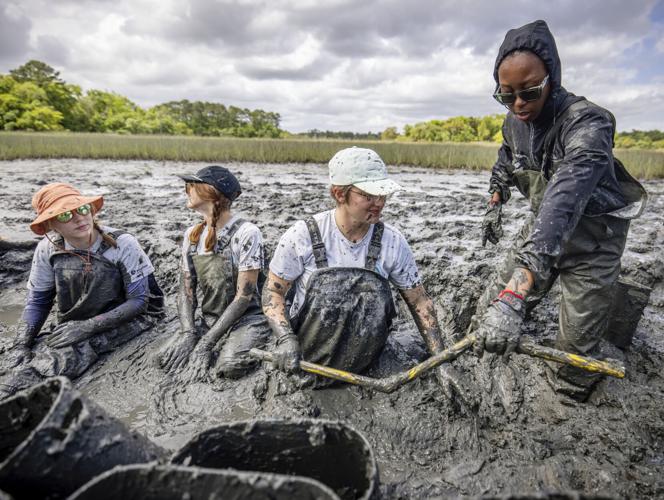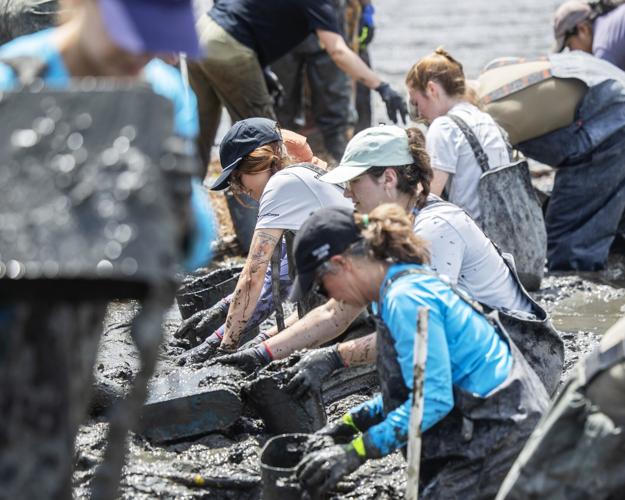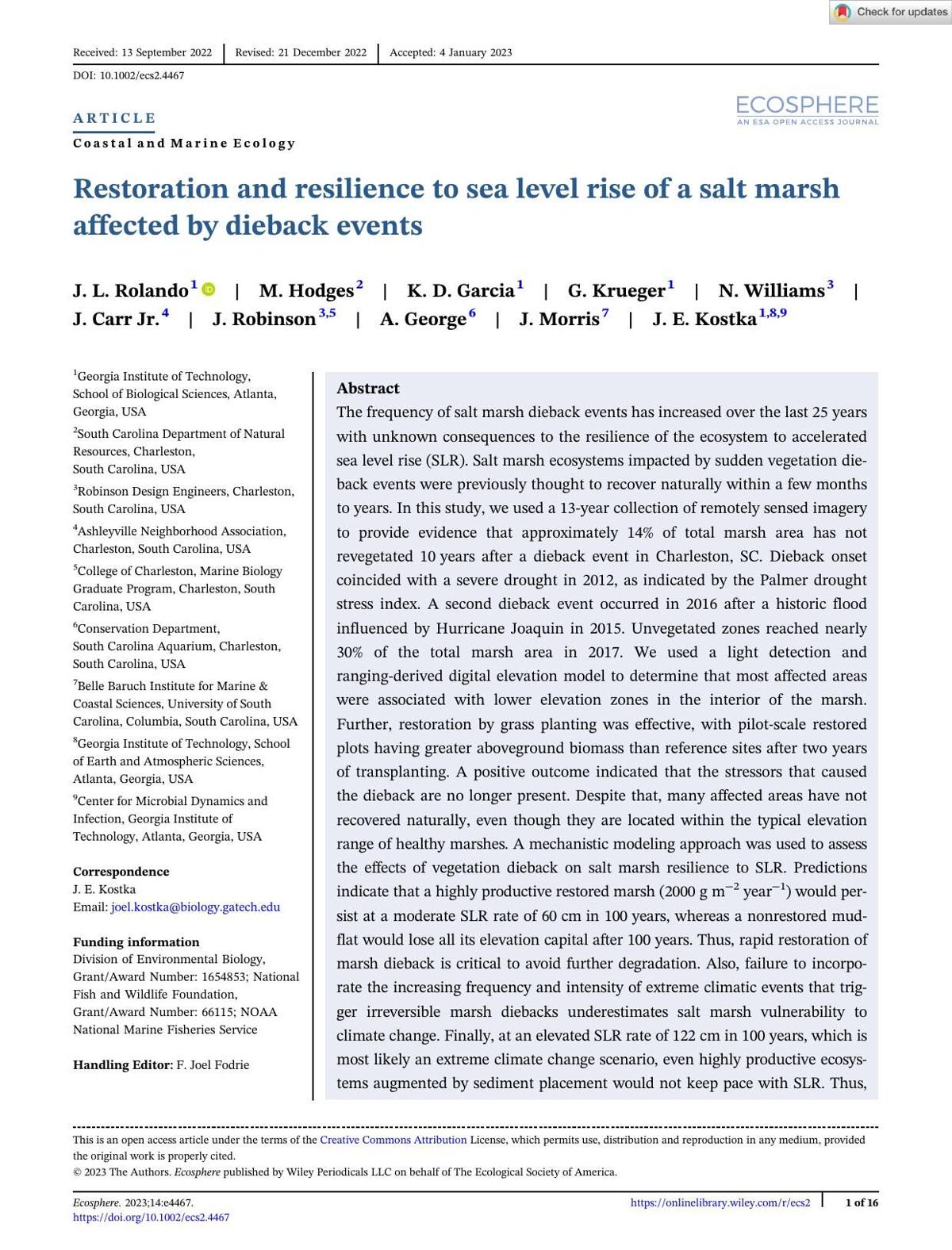The volunteers walked gingerly in single file, feeling with their feet for the wooden planks buried in pluff mud. The planks made it easier to walk through the salt marsh, but they were beginning to shift and separate — one misstep and you’d sink a few feet in the soft, pillowy mud and have to shimmy out.
“It’s always a good day when you get to play in the mud,” S.C. Aquarium manager Kelly Thorvalson said, making her way back to solid ground.

Citadel student Eric Sheppard carries wooden planks into the pluff mud.
These volunteers were part of the latest effort to save the salt marsh behind John Carr’s family home in Ashleyville. Over the course of three days, April 8-10, roughly 60 volunteers moved more than 8,000 gallons of pluff mud by hand to carve out a new tidal channel.
This 185-foot tidal channel is the second of three that will make the marsh more resilient to flooding and drought in the future, according to Kelly Lambert, S.C. Department of Natural Resources biologist and project lead. The first channel was excavated in 2023, and the third will be excavated in 2025.
The hope is that these new tidal channels will nourish the marsh and help the grass grow back after two major dieback events in the last decade. A successful renourishment could help the saltmarsh — and neighboring communities — bounce back from climate events, such as drought, floods and sea-level rise. The National Oceanic and Atmospheric Administration estimates that 1 acre of wetlands, including salt marshes, can capture up to 1.5 million gallons of floodwater.
Restoring a marsh by hand-excavating tidal channels is a novel method, and time-consuming, but necessary, SCDNR biologist Michael Hodges said.
“You could go in with excavators and probably excavate all three of these channels within a couple days,” he said. But this would cause more environmental harm to the sensitive marsh ecosystem that has already been struggling for decades.

Volunteers dig out pluff mud by hand to excavate a new tidal channel in a salt marsh in Ashleyville on April 10, 2024, in Charleston.
Salt marsh history
Carr spent his childhood swimming, hunting and crabbing in the salt marsh in his backyard.
His own family home was floated in on a rice barge when this West Ashley community was known as Maryville — a self-sustaining African American community that formed in 1886. The town became a haven for formerly enslaved people seeking to own land, live and work in peace during the Jim Crow era.
“We were considered a model of Black self-government,” said Marsha Higgins, president of the Maryville-Ashleyville Neighborhood Association. The town had its own mayors, police department, post office and schools.
Carr’s grandfather served as the last mayor before the S.C. General Assembly revoked the town’s charter in 1936, The Post and Courier previously reported.
For generations, the salt marsh provided refuge, beauty, food and recreation for the community, Higgins said.
Salt marshes are dynamic ecosystems; a little fluctuation is normal, Hodges said. But Carr started to notice changes that seemed a bit more permanent: The marsh grass retreated from the bank, then disappeared altogether. The landscape turned muddy.

Volunteers place wooden planks into pluff mud to allow them to walk across the salt marsh behind John Carr’s family home in Ashleyville on April 10, 2024, in Charleston. More than 8,000 gallons of pluff mud were moved by hand to excavate a new tidal channel.
The salt marsh was dying, he said.
Carr first suspected chemicals were polluting the water and worried for the health of his community members. He sprang to action, raising concerns over the community’s marsh with anyone who would listen.
Most didn’t. Then, after a decade, someone finally did, he said.
Albert George, a former conservation director at the South Carolina Aquarium, worked with Carr to get local organizations on board to save the marsh, Carr said.
The state DNR got grant funding in 2019 from the National Oceanic and Atmospheric Administration to plant around 54,000 stems of marsh grass. Its success led to another grant to create a restoration plan with the help of Robinson Design Engineers, Hodges said.

Small trash bins are used to move more than 8,000 gallons of pluff mud for a new tidal channel in a salt marsh behind John Carr’s family home in Ashleyville on April 10, 2024, in Charleston.
The latest effort to hand-excavate tidal channels, stabilize them with oyster reefs and plant marsh grass is funded by a third grant, which started in January 2023 and will end in December 2026. The grant includes $1.5 million in federal funding and an additional $1 million matched by SCDNR, Hodges said.
The project depends on support from volunteers. In the most recent excavation, they included employees from Trident Construction, the Sustainability Institute, the South Carolina Aquarium and Charleston Waterkeeper, as well as Citadel cadets and a homeschooling group.
“This project has taught me that anything is possible with a large group of people and with the right determination,” Lambert said.

Kelly Lambert, wildlife biologist with South Carolina Department of Natural Resources, leads a group of volunteers in excavating a tidal channel in a salt marsh behind John Carr’s family home in Ashleyville on April 10, 2024, in Charleston.
Drought and flood
Georgia Tech biologist Joel Kostka and his team started mapping the salt marsh in 2019 to figure out what happened. They ruled out chemical pollutants, easing Carr’s worries, and determined the dieback was the result of a combination of environmental shifts.
They estimated that sometime between 1919 and 1958, the Old Town Creek, which feeds the marsh, shifted north. This shift starved the marsh of its natural flows, Hodges said.
The historic drought in 2012 led to the first dieback. Saltmarsh cordgrass, the dominant species in the marsh behind Carr’s home, is very salt-tolerant, Kostka said.
These plants move salt water through their tissues and filter out the salt, which is expelled through their leaves. Though efficient, this process puts more salt back into the soil. When combined with drought, which also brings saltier conditions, the result can be catastrophic for plants, Kostka said.
Then flooding in 2016, influenced by Hurricane Joaquin in 2015, suffocated the surviving grasses. The loss of natural flow, plus drought and severe flooding within a relatively short amount of time, “stressed out that marsh beyond its ability to (repair) naturally,” Hodges said.
The new tidal channels are designed to alleviate this stress and make the salt marsh more resilient to drought, flooding and sea-level rise. At its deepest, the new tidal channel is just under 2 feet. The hand-excavated channel gets slightly shallower every 50 feet to work with the natural elevation of the marsh, Hodges said. Mimicking natural creeks, these channels will bring in tidal water and the nutrients the newly planted grasses need to grow.
“They’re the lifeblood of the marsh plants,” Kostka said.
In the summer, SCDNR will plant marsh grasses and install oyster reefs along the edges of the excavated tidal channel to prevent erosion, Lambert said. Throughout the year, Kostka and his team will monitor how the tides continue to shape the new creek and the health of the new plants.
A community effort
The Maryville-Ashleyville marsh restoration project has been a huge learning experience for all involved, introducing a new restoration technique and relying on community engagement, Hodges said.

Linda Rowe, conservation programs coordinator with the South Carolina Aquarium, passes along a small trash bin filled with mud as she works with other volunteers to excavate a new tidal channel in a salt marsh behind John Carr’s family home in Ashleyville on April 10, 2024, in Charleston.
“We’ve never taken on a project of this scope with this much involvement at any one site, particularly something to this scale,” he said.
In September 2023, the Aquarium, SCDNR and Kostka’s team from Georgia Tech presented project updates to the community. The Aquarium also offered the community free admission to its exhibits. Higgins said these experiences make the community feel like partners on the project.
The Aquarium will hold additional workshops this year to share project updates, ask for feedback and empower community members to become citizen-scientists and monitor the marsh themselves, Aquarium Conservation Director Sara McDonald said.
“This is their marsh,” she said.
Hodges said he wishes he had asked community members what marsh restoration means to them from the beginning — a question often discussed within the science community.
“The word restoration is brought up a lot through practitioners — restoration, oyster restoration, marsh restoration — well, restore it back to what?” Hodges said. “Are you restoring ecosystem services or are you restoring it back to what it was?”
Carr said he would like to see the marsh restored to what it was like when he was a kid. But that would likely require dredging, which could damage the salt marsh.
Scientists want to see the marsh become a thriving ecosystem again, with natural grass growing, water flowing and birds and other wildlife calling it home, Lambert said.
“The marsh is constantly changing, so it won’t ever fully be restored to what the neighborhood remembers, but we want to see a healthy marsh,” she added.
Carr said he’s happy something is being done to save it. He pointed to the grasses flourishing near the bank and extending to the far side of the marsh.
“When they first came … all of this was nothing but mud,” he said.
What happened to the marsh in Carr’s backyard is happening in other places — salt marshes are imperiled throughout the country because of environmental changes, human development and sea-level rise. Perhaps the methods being tried out in Ashleyville could be applied elsewhere, Carr said.
“If this is happening up and down the coast on both sides of the country, and the (potential) cure for it is in my backyard, that just means a lot to me,” Carr said.

Kelly Lambert, wildlife biologist with South Carolina Department of Natural Resources, walks out of the marsh after leading volunteers in excavating a tidal channel in a salt marsh behind John Carr’s family home in Ashleyville on April 10, 2024, in Charleston. More than 8,000 gallons of pluff mud were moved by hand over three days for the new tidal channel.



















